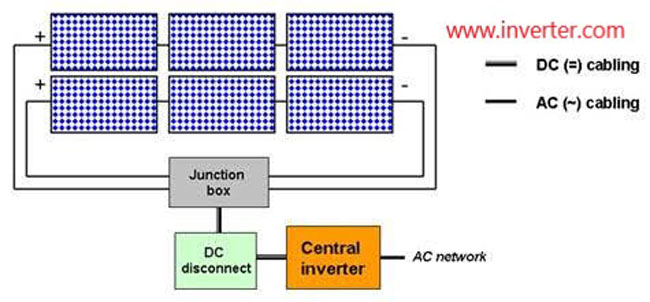Solar inverter is the heart of the solar plant, it represents the main equipment that converts DC output from solar panels to AC electricity required to run all our appliances/machines/equipment. In addition, it takes the responsibility of monitoring and controlling the PV array system.
The central solar inverter usually placed near the main electricity service switchboard, and in protected area, so no worries about harsh environment climate conditions.
All DC terminals from solar panels will be gathered in combiner box input and the output will go to the central solar inverter, so its one inverter that will handle all the solar array, that is why the central inverter power capacity is higher than string solar inverter and micro solar inverter. At solar central inverter DC side, the DC voltage will be high; around 600-1000VDC, and inverter power capacity will be high as well, it may reach to 5MW or so.
What are the advantages of central solar inverter?
1. Trust and proven Technology:
The central solar inverter has been existing for long time, many years ago, we deal with, it has been installed and doing well years ago, and this gives it more credibility.
2. Less expensive:
Compared to other types of solar inverters (string & micro), it is less expensive because lower components and lower installation costs due to its one inverter that can handle all the solar array.
3. More reliability:
As mentioned, we usually place the central inverter inside a room or closed area, and apart from bad weather, it’s not exposed to harsh climate conditions, these of course increase the reliability of this system.
What are the disadvantages of central solar inverter?
1. High influence in case of shaded or failed solar panels:
As most of solar panels incase of central inverter system are connected in series, so if only 5% of solar panels are shaded or failed due to any reason, they will affect on the entire system and we lose approx 20% of system output power.
2. High DC voltage risk, and only one inverter:
The DC voltage incase of central inverter will be high, it reaches 1000VDC or higher, which raise concerns on installer and operators, in addition, its one inverter, so incase of any fault, we shall lose the entire solar system.
3. High replacement costs:
Its high capacity and cost solar inverter, so in case of failure, replacement costs will be higher than others solar inverters types.
